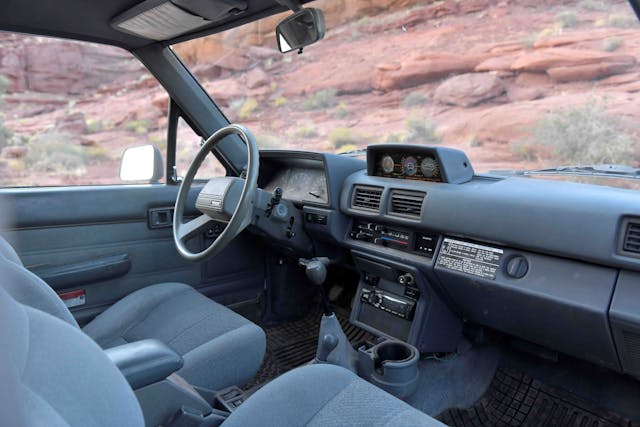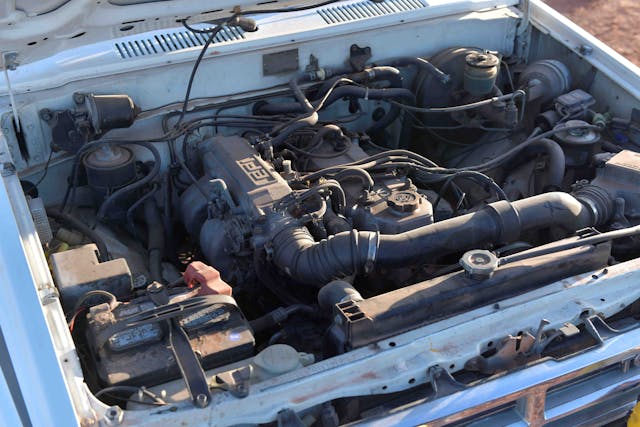Toyota’s first-gen 4Runners offer go-anywhere fun with affordability
In 1984, a new wave of small SUVs began to flood the market. Chevy had introduced the S-10 Blazer the year before, and the Ford Bronco II, the Jeep Cherokee, and the Toyota 4Runner were hot on its heels, with more to come. Car and Driver called them “smaller, more civilized, more comfortable, but still rugged four-wheel drive, multipurpose runabout/haulabouts.”
Based on Toyota’s small 4×4 pickup, which already had a reputation for indestructibility, the 4Runner had a solid front axle and, according to Toyota, the most ground clearance in the class. SR5 models even got a dash-mounted altimeter and inclinometer. The 4Runner had the off-road chops to entice those mourning the legendary FJ40 Land Cruiser, which had left the U.S. market in 1983.
The two-door sport ute also had a cool So-Cal beach cruiser vibe its rivals lacked, with a unique removable rear roof secured by 14 bolts and a standard roll bar behind the back seat. Its power rear glass even retracted into the tailgate so you could hang your longboards out the back. Toyota played up the fiberglass cap in its advertising: “First, take off the removable rear top and let the sunshine in. Then pile in. Kick it into four-wheel drive and blaze a trail to your favorite spot. Now that’s having a good time with style.”

The first-gen 4Runner was part pickup, part SUV, and part Jeep CJ. Two trim levels were offered, with the upscale SR5 getting interior upgrades and the back seat, gradated strobe-stripe graphics, and chrome wheels. Starting in 1985, you could add the back seat to the base model, but Toyota never put shoulder belts back there.
In 1986, an independent setup with a 3-inch-wider track replaced the solid front axle. The change bettered ride quality and stability, but purists still search out the early trucks, even with their meager power. The pickup’s borrowed 2.4-liter inline-four with a two-barrel carburetor makes just 96 horsepower and is taxed by the SUV’s several hundred pounds of additional weight. It worked exclusively through a five-speed manual.

Toyota added fuel injection the second year and horsepower jumped to 100. A 116-hp version was also offered, and in 1986 and 1987 a 135-hp turbocharged four was available. That engine came with the manual, but most were SR5s with the optional four-speed automatic. In the final two years of production, a 3.0-liter SOHC V-6 was offered. It was rated at 145 hp and 185 lb-ft of torque, with a bump to 150 hp in 1989. SR5s with the V-6 and five-speed got auto locking front hubs. Over the years, 0-60-mph times dropped from months to weeks to about 12 seconds. These trucks do not have ABS, and air conditioning was optional, even on the SR5. In 1990, Toyota redesigned the 4Runner, adding back doors and a fixed steel roof, the configuration it retains in the current fifth generation.

Like any open vehicle, rust is an issue. Replacement front fenders are available, but floors and quarter panels are not. Replacement carpets exist, but other interior items like reproduction seats and upholstery don’t, so aftermarket stuff like “racing seats” are common, as are lift kits and other mods, including Marty McFly–style tubular bumpers and KC lights.
Despite challenging parts availability, early 4Runners have gotten crazy popular very quickly. If you really want to own the next Radwood event, pack yours with a gnarly Lance Collins shortboard and a vintage PK Ripper. Now that’s having a good time with style.
1987 Toyota 4Runner SR5
Engine: 2.4-liter I-4
Power: 116 hp @ 4800 rpm
Torque: 140 lb-ft @ 2800 rpm
Weight: 5100 lb
Clearance: 7.7 in (from differential)
Cargo space: 81 cu-ft
Price when new: $14,548
Hagerty #3-condition value: $7100–$16,200


